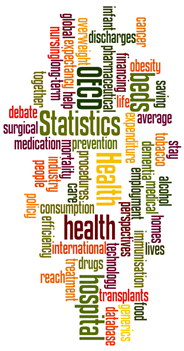
Total health spending accounted for 9.1% of GDP in Australia in 2011-2012, slightly lower than the average of 9.3% in OECD countries in 2012. Health spending as a share of GDP is much lower in Australia than in the United States (which spent 16.9% of its GDP on health in 2012) and in a number of European countries including the Netherlands, France, Switzerland and Germany (all allocating over 11%).
The public sector is the main source of health funding in nearly all OECD countries. In Australia, 68% of health spending was funded by public sources in 2011-2012, below the average of 72% in OECD countries.

Unlike in many other OECD countries, health spending in Australia has hardly been affected by the economic crisis. In 2011-2012, health spending in Australia has gone up by over 5% in real terms compared to a 1% increase on average across OECD countries. This strong increase in Australia was triggered by substantial growth in spending on outpatient curative care, administration and public health services.
The growth rate in pharmaceutical spending in 2011-2012 in Australia was fairly modest, but this followed strong growth rates of over 6% per year in real terms in years prior to that. In most other OECD countries, expenditure for pharmaceuticals has been declining since 2010.
Growing number of doctors in Australia
There has been a substantial increase in the medical workforce in Australia since 2000, coinciding with the rise in the number of medical graduates. In 2012, Australia had 3.3 practising physicians per 1000 population, up from 2.5 in 2000, and now slightly above the OECD average (3.2). While a greater number of doctors will improve access to health care, this is also putting pressure on current training capacity and will put pressure on future health care budgets as more graduates enter the medical workforce.

Health status and risk factors
In 2012, life expectancy at birth in Australia was 82.1 years, almost two years higher than the OECD average of 80.2 years. Life expectancy in Australia remains among the highest in OECD countries, following Japan, Iceland, Switzerland, Spain, Italy and France.
Australia has achieved remarkable progress in reducing tobacco consumption, cutting by more than half the percentage of adults who smoke (from 35.4% in 1983 to 15.1% in 2010). The smoking rate in Australia is now one of the lowest in OECD countries. Much of this decline can be attributed to policies aimed at reducing tobacco consumption through public awareness campaigns, advertising bans and increased taxation. As of 1 December 2012, Australia became the first country in the world to require tobacco products to be sold in plain packaging.
Obesity rates have increased in recent decades in all OECD countries, although notable differences remain. In Australia, the adult obesity rate, based on measures of height and weight, was 28.3% in 2011. This is lower than in the United States (35.3% in 2012) and Mexico (32.4% in 2012), but much higher than the average for the 16 OECD countries with measured data (22.7%). The growing prevalence of obesity foreshadows increases in the occurrence of health problems (such as diabetes and cardiovascular diseases), and higher health care costs in the future.

Source: http://www.oecd.org/els/health-systems/Briefing-Note-AUSTRALIA-2014.pdf
